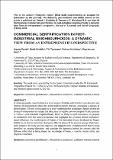Commercial gentrification in post-industrial neighbourhoods : a dynamic view from an entrepreneur's perspective
Abstract
In urban geography research there is a small supply of articles which reflect upon the aims and motives of entrepreneurs when they enter neighbourhoods that are undergoing a process of gentrification. The aim of this paper is to better understand the explanatory factors behind the timing of entrepreneurial changes that take place during the commercial gentrification process in Tallinn’s post‐industrial neighbourhoods. Based on thirty in‐depth interviews, we propose an explanation from the supply perspective that highlights the dynamics behind motivation‐based influences. By modifying the diffusion of the innovation theory developed by Rogers we are able to show how, during the different phases of the process, groups of pioneers, early adopters, the early and late majority, and laggards enter a neighbourhood that is being gentrified by varying objectives, and associate the dynamics behind the process with the follower effect that is being shaped by knowledge diffusion, a specific market niche, and physical co‐location.
Citation
Pastak , I , Kindsiko , E , Tammaru , T , Kleinhaus , R & van Ham , M 2019 , ' Commercial gentrification in post-industrial neighbourhoods : a dynamic view from an entrepreneur's perspective ' , Tijdschrift voor Economische en Sociale Geografie , vol. Early View . https://doi.org/10.1111/tesg.12377
Publication
Tijdschrift voor Economische en Sociale Geografie
Status
Peer reviewed
ISSN
0040-747XType
Journal article
Description
This work was supported by the European Commission under the 7th Framework Programme (Project No. 319970, DIVERCITIES) and by the Estonian Ministry of Education and Research (grant number IUT20-49).Collections
Items in the St Andrews Research Repository are protected by copyright, with all rights reserved, unless otherwise indicated.

